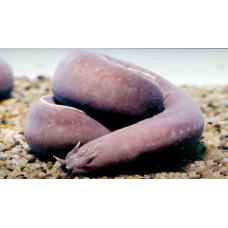A subclass of the most primitive vertebrates, lacking true jaws and paired limbs. The chord is retained throughout life. The mouth is shaped like a suction cup. Jawless vertebrates have no bony tissue in the skeleton and no paired fins. The sac-like gills are of entodermal origin, unlike fish gills. The gill skeleton is peculiar, lying under the skin outside the gill arteries and nerves. The inner ear has only two semicircular canals, not three as in jawed fishes. Cerebral skull is cartilaginous (sometimes partially ossified) and covers the brain only at the bottom and sides. Only caudal and 1-2 dorsal fins developed. Leads a parasitic lifestyle. Found in marine and fresh waters. Two classes of lampreys (Cephalaspidomorphi) and hagfish.
Myxinids and lampreys are the modern representatives of invertebrates. Their first fossil remains are known from strata 300 and 330 million years old, respectively. According to current hypotheses, myxinids and lampreys are a relict group of ancient skulls with many primitive structural features (absence of jaws, paired fins, vesicular gill structure, presence of an external digestive canal, a semicircular canal in the inner ear, etc.). According to modern theories, the primitive body structure of members of these classes is a consequence of their ancient origin rather than a secondary simplification due to their now inherent lifestyle of parasitism or carrion feeding.
Some morphological analyses have reconstructed the roundworts as a paraphyletic group, with lampreys more closely related to jawbreakers than to hagfish. Many authors accepted the results of these analyses and began to consider lampreys and hagfishes as separate classes or infratipes. However, subsequent molecular genetic and some morphological analyses support the monophyly of the lampreys.
The supraclasses of the invertebrates include the following classes:
Orders incertae sedis
Class Myxini - Myxinae
Class Petromyzontida - lampreys
Class Anaspida - Anaspidae, or wingless or flapless
Class Cephalaspidomorphi - Neparnosporous or Cephalaspidomorphs
Class Conodonta - Conodonts (sometimes disputed)
Class Pteraspidomorpha - Parnosporous or pterospidomorphs
Class Thelodonti - Thelodonti
Jawless (Agnatha)
Tags: Jawless (Agnatha)




